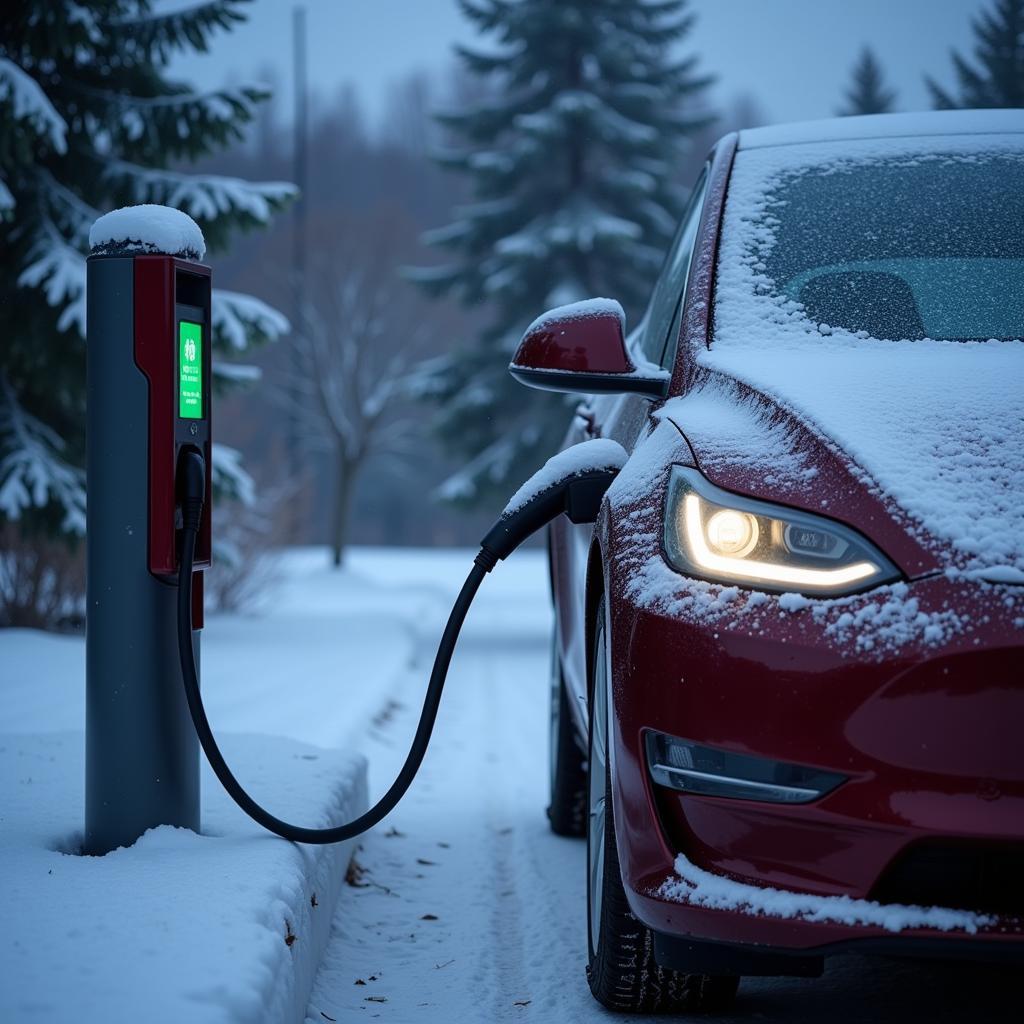Winter’s icy grip can pose unique challenges for electric car owners. From reduced range to charging difficulties, understanding these issues is crucial for a smooth winter driving experience. This article delves into the common problems electric vehicles face in cold weather and offers practical solutions to keep you moving, no matter how low the temperature drops.
 Electric Car Winter Charging Challenges
Electric Car Winter Charging Challenges
One of the most significant issues is the impact of cold temperatures on battery performance. Just like your phone battery drains faster in the cold, EV batteries lose capacity when the mercury dips. This can lead to a noticeable reduction in range, sometimes by as much as 40%. Pre-heating your car while it’s still plugged in can help mitigate this, as it warms the battery and cabin without using stored energy. You might also consider driving at lower speeds and limiting the use of energy-intensive features like heated seats and steering wheels to maximize your range. You can learn more about issues that arise when the engine is cold by checking out our article on car problems when engine is cold.
How Does Cold Weather Affect EV Range?
Cold temperatures slow down the chemical reactions within the battery that produce electricity. This results in a decrease in the available energy and, consequently, a shorter driving range. Think of it like molasses flowing slower in the cold.
“In extreme cold, drivers should anticipate a significant reduction in their EV’s range,” advises John Smith, a senior automotive engineer at a leading electric vehicle manufacturer. “Planning ahead and adjusting driving habits are key to avoiding any unexpected inconveniences.”
Charging Challenges in Winter with Electric Cars
Charging your electric car in winter can also present its own set of hurdles. Lower temperatures can affect the charging speed, particularly with slower AC chargers. Furthermore, some public charging stations may be impacted by snow or ice, making them inaccessible.
Tips for Charging Your EV in Cold Weather
- Use a garage whenever possible: A warmer environment will help maintain battery temperature and optimize charging speed.
- Consider a Level 2 charger: These chargers are generally faster than Level 1 chargers and less susceptible to cold-weather slowdowns.
- Pre-condition your battery: Many EVs offer a pre-conditioning feature that warms the battery before charging, improving efficiency. This is particularly helpful when using fast DC chargers.
- Clear snow and ice from the charging port: This ensures a proper connection and prevents damage to the charging equipment. Problems with starting your car in winter aren’t limited to electric vehicles. Check out our article on winter car starter problems for a broader perspective.
“Keeping your charging port clear of snow and ice is essential,” adds Jane Doe, an experienced EV technician. “It not only ensures a successful charge but also prevents potential damage to the charging system.”
Other Winter Woes: Tire Pressure and Cabin Heating
Cold weather also affects tire pressure in electric cars, just as it does in gasoline-powered vehicles. The lower temperatures cause the air inside the tires to contract, leading to a decrease in pressure. Regularly checking and adjusting your tire pressure is crucial for maintaining optimal handling and efficiency. Additionally, heating the cabin in an electric car can draw significant power from the battery, further impacting range. Using the pre-conditioning feature while the car is plugged in can help minimize this drain.
Problems with Electric Cars in Winter: Conclusion
While winter can present some challenges for electric car owners, understanding these issues and taking proactive steps can significantly improve your winter driving experience. By following the tips outlined in this article, you can ensure that your electric car remains a reliable and efficient mode of transportation, even in the coldest months. Contact us at AutoTipPro at +1 (641) 206-8880 or visit our office at 500 N St Mary’s St, San Antonio, TX 78205, United States for any assistance. Some car problems are notoriously difficult to diagnose, as explained in our article on cars in the garage problem solving. For those interested in exploring potential issues with different engine types, our article on problems with 2 cylinder cars provides valuable insights. Finally, if you’re curious about which cars tend to have the most problems, our article on car with most problems offers a comprehensive overview.




Leave a Reply